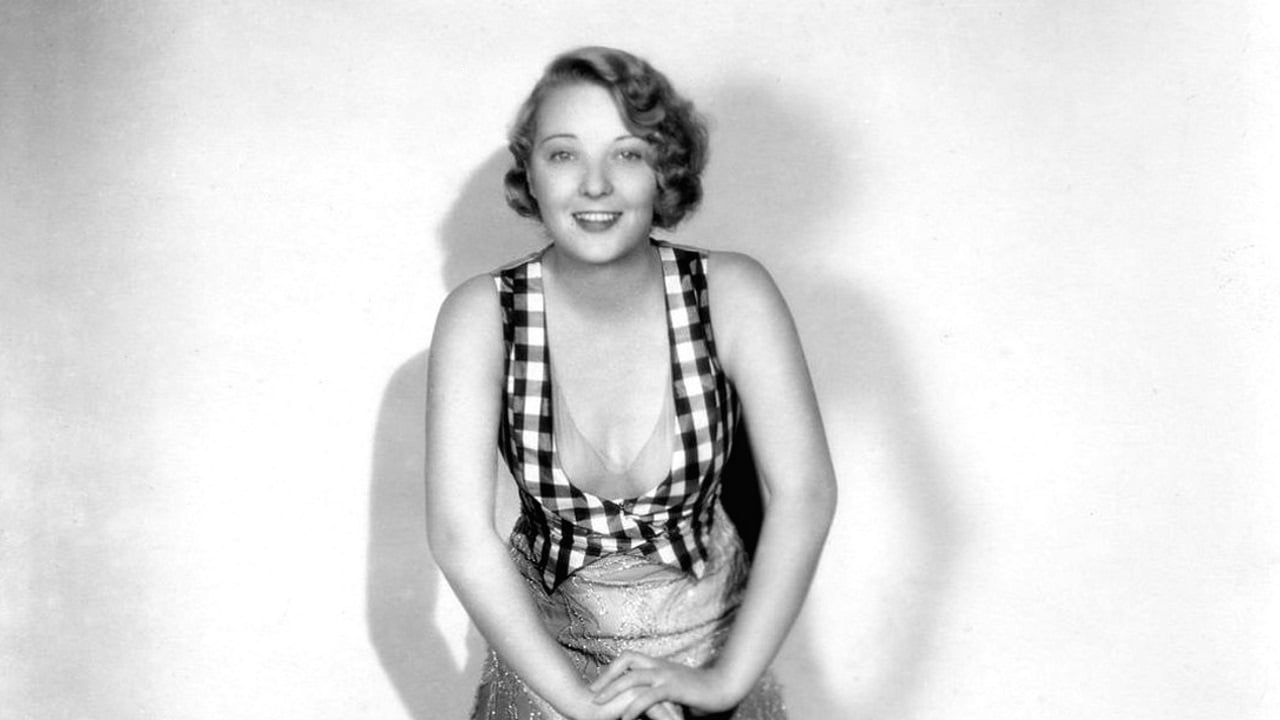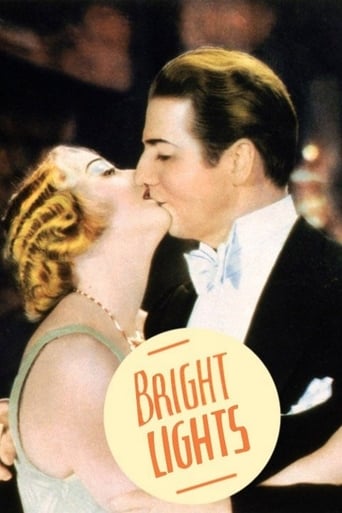



Highly Overrated But Still Good
a film so unique, intoxicating and bizarre that it not only demands another viewing, but is also forgivable as a satirical comedy where the jokes eventually take the back seat.
View MoreThe biggest problem with this movie is it’s a little better than you think it might be, which somehow makes it worse. As in, it takes itself a bit too seriously, which makes most of the movie feel kind of dull.
View MoreThe tone of this movie is interesting -- the stakes are both dramatic and high, but it's balanced with a lot of fun, tongue and cheek dialogue.
View MoreA musical/comedy/drama starring some long-forgotten Broadway and Hollywood stars. Dorothy Mackaill stars as Broadway star hiding her sleazy past from her tycoon fiance. Her partner is stage actor Frank Fay, who is about to lose her to marriage, and Noah Beery plays the heavy who remembers her 'way back when'. There are several musical numbers interspersed but the songs are not memorable - long forgotten, like this picture. There are scenes that are alternately dramatic and comical, as the film can't decide which it is.It was entertaining, particularly if you are a "movie archaeologist" and enjoy seeing stars of long ago, stars who haven't seen the light of day in years. I like Mackaill and had never seen Fay, although my parents talked about him from his stage roles. Frank McHugh as a drunken (as usual) reporter, Eddie Nugent and Daphne Pollard are some of the other names sure to please old movie fans.6/10 - The website no longer prints my star ratings since the changeover.
View More"Bright Lights" was for years virtually unseen, unappreciated in its day due to the huge number of musicals that exploded across early talkie screens. Shot by director Michael Curtiz in two-strip Technicolor in Dec 1929, its belated release on Sept 21 1930 found an unreceptive audience, so the film was pulled back, its 73 minute running time trimmed by five minutes, and reissued under the new title "Adventures in Africa" (the only existing title on all current prints, all unfortunately in black and white). Top billed Dorothy Mackaill had been a huge star in silents, somewhat overshadowed by the large cast, but still able to spice things up in all her scantily clad glory, director Curtiz failing to hide anything as she undresses in silhouette. Her singing isn't too bad either, but the songs tend to slow the pace of a wild, over the top script that juggles her impending marriage to wealthy socialite Fairchild (Philip Strange) with various backstage shenanigans on the night of her farewell performance. Frank Fay, then husband of Barbara Stanwyck, co-stars as Louanne's possessive former partner, who listens to her stories to the press about some of her past experiences, including a naval baring number in South Africa titled "Song of the Congo," witnessed by Portuguese smuggler Miguel Parada (Beery), whose lascivious attempt at rape finds her throwing a lit oil lamp at his face. Now on her last night in the Broadway footlights, Miguel (to no one's surprise) just happens to be in the audience, a hidden gun just waiting to exact revenge. It's somewhat jarring to find such a comedic ensemble huddled into a murder mystery for the film's second half, after Miguel winds up shot dead with his own pistol (at least the pace picks up at this time). The solution doesn't make much sense, and the possibility of a second murder at the fadeout really makes this musical a true pre-code oddity (lots of suggestive dialogue survives: "that's the cleanest proposition I've had all day!"). While most of the performers have long since faded from memory (Dorothy's making a comeback, God bless her), one uncredited actor was here making his screen debut at age 23, a Shakespearean wannabe calling himself 'Peter Richmond,' eventually going by the name John Carradine by 1935. Arriving in sunny California in 1927, Carradine was living a vagabond life, working as an artist and dishwater to make ends meet when not performing on stage, meeting his idol John Barrymore around this time with the goal of doing "Richard III." In adopting Barrymore's lifestyle of drinking and carousing, the already flamboyant Carradine found a kindred spirit, each possessing 'The Divine Madness,' forever looking down his nose at movie work, never mentioning this film while touting his next title, "Tol'able David," as his first (understandable, since there he had a featured role). In "Bright Lights," Carradine appears at the 11 minute mark for a period of 20 minutes, mostly off camera among the many newshounds gathered in Louanne's dressing room for a spot of note taking. He's the tallest one, clean shaven and wearing a hat, a newspaper photographer who gets to speak two lines, a total of four words: "Telegraph here" and "sure, sure!" Always seen in the background, he enjoys over two minutes screen time, while the unbilled blonde chased by boozing reporter Frank McHugh, Violet Madison (Jean Laverty), surely deserved a screen credit ("no matter where you hide it, I'll find it!"). He undoubtedly looked upon this as a quick buck, not intending to have a future in the movies, but by 1936 his screen career was assured, his affinity for on screen perfidy earning him kudos in John Ford's "The Prisoner of Shark Island."
View MoreMaria Montez was once quite rightly dubbed Queen of Technicolor. As for the King? Well, there was a King, true, but he wasn't an actor (at least not a regular actor). He was director Michael Curtiz, called the King of Technicolor because it was claimed he directed more Technicolor (two-strip and three-strip Technicolor, that is) movies than anyone else. A difficult assertion to prove or disprove. Certainly Curtiz was King of Technicolor on the Warner Bros. lot. Maybe over-all. I'll leave that for some other researcher to ponder. What we do know for a fact is that 1930 was one of Technicolor's greatest years. Sixteen full-length features plus one, M-G-M's The March of Time shelved and never released, plus eighteen features with Technicolor sequences, totals thirty-five — a figure not exceeded until 1948. Warner Bros.-First National were responsible for no less than sixteen of these Technicolor releases, but only three were directed by Curtiz: Bright Lights, Under a Texas Moon and sequences in Mammy. Just about all the Warner-First National output were musicals (no wonder the public tired of the genre so quickly in 1930). Bright Lights is no exception. It's a shame in fact that even more songs weren't packed in to edge out even more of the silly story. It would have to be the most stupid, most idiotic, most unbelievable, most melodramatically ridiculous plot I've ever encountered. At least it's original. No-one would ever want to copy or imitate it, that's for sure!However, the story does allow us to evaluate the players, particularly lovely, charismatic, almost forgotten, British-born Dorothy Mackaill, a big star in silents who made the transition to sound with no problems at all, but was left on the sidelines when Warner Brothers bought out First National and began trimming National's star roster at the height of the Depression. Another problem – not of Dorothy's making, but entirely the fault of Jack Warner – was that her vehicles were not popular with the public. This one, chock-a-bloc with elaborate production numbers, hit theaters when the public was absolutely fed up with musicals. Hence a desperate title change to Adventures in Africa which was not only inappropriate – the "African" footage didn't amount to more than ten minutes – but wildly deceptive. So who did people blame? Jack Warner? No! Mike Curtiz? No! "Humph" Pearson and Henry McCarty? No! Even over-zealous Frank Fay who out-stays his welcome. No! This was only Fay's third feature film, and he had no box office drawing power anyway. For 99% of moviegoers, Dorothy Mackaill was number one on their hit list. My dad thought that the sole function of producers was to shell out the money and that directors were in charge of photography and other technical aspects. As for the stars – they made up their own scripts and directed themselves! And those notions was shared by almost the entire line-up of rank-and-file picturegoers. So if they hated Adventures in Africa – which they did (in spades) – the number one (and perhaps only) figure on their hate lists was Dorothy Mackaill. True, Frank McHugh's inebriated reporter hit the spot, but his routines ranked a poor second to all that singing and dancing – which you and I love, but which back in 1931, just about everyone from critics to choir boys hated!
View MoreIt is a shame that no Technicolor print of this Vitaphone musical has survived, because the aesthetic oddities of the 2-color process would be a match for this preposterous Broadway story. Star Louanne (Mackaill) plans to marry a rich dud, but deep down pal Wally (Fay). Sadly, Wally is a jerk. There is a flashback to an African local (like Disney's Tarzan, sans Africans), and some silly backstage gunplay. Frank McHugh is swell as a drunk reporter. Mackaill is appealing in the production numbers, but as lost as everyone else with the poor script. Guilty fun for fans of early musicals, though.
View More